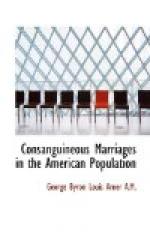In those cases of deafness which, in the Census returns, are ascribed to specific causes, the factor of consanguinity is still noticeable, although the percentage of the non-congenitally deaf who are the offspring of cousins never exceeds 5.3 (Table XXVIII). But the influence of heredity is not removed by the elimination of the congenitally deaf. Many instances are known where successive generations in the same family have developed deafness in adult life, often at about the same age and from no apparent cause. The following case well illustrates this point. It is furnished me by a correspondent in whom I have great confidence. The facts are these: A—— aged 28 married B—— aged 19, his first cousin who bore the same surname as himself. Both lived to old age and were the parents of eight children, two of whom died in infancy. My informant further states:
Having personally known very well all of the surviving six children of this family, I can truthfully state that all were unusually strong, active and vigorous people and all the parents of healthy children. A—— was troubled with deafness as long as I can remember, and this physical trait he transmitted to all of his children, though some of them did not develop the same till well along in life. C—— (the youngest son), however, began to indicate deafness quite early. No one of his four children is in the least deaf.
It will be noticed here that whereas in the case of the cousin marriage the trait was so strongly inherited, it disappeared entirely in the next generation with a non-consanguineous marriage. The inheritance of tendencies or weaknesses may be more common than the actual inheritance of defects. Dr. Bell’s words on this point are suggestive:
Where a tendency toward ear trouble exists in a family, it may lie dormant and unsuspected until some serious illness attacks some member of the family, when the weak spot is revealed and deafness is produced. We are not all built like that wonderful one-horse shay that was so perfectly made in all its parts that when at last it broke down it crumbled into dust. When an accident occurs it is the weak spot that gives way, and it would be incorrect to attribute the damage to the accident alone and ignore the weakness of the part; both undoubtedly are contributing causes.
In the case, then, of a deaf person who has deaf relatives, the assigned cause of deafness may not be the only cause involved, or indeed the true cause at all. It may be the cause simply in the same sense that the pulling of a trigger is the cause of the expulsion of a bullet from a rifle, or a spark the cause of the explosion of a gunpowder magazine; hereditary influences may be involved.[92]
[Footnote 92: U.S. Census Report on the Blind and the Deaf, p. 127.]




